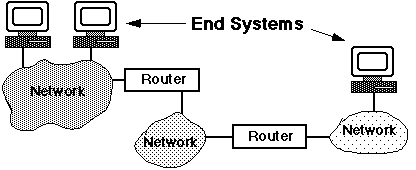
TCP relies on the Internet Protocol (IP) to deliver packets of data from one edge system to another. The packets which IP delivers are usually called datagrams.
Datagrams navigate zero or more (sometimes many) routers, interconnecting the individual networks which together make up the Internet. The word "Internet" is just a contraction of the phrase "Interconnected Networks".
A router is essentially a special-purpose computer whose sole function is to transfer datagrams between networks. In earlier times, they were called "IP Gateways". The general structure of the Internet can thus be visualised:
Internet addresses are always written as a dotted sequence of the form:
where aa, bb, etc, are the decimal values (ranging from 0 to 255) of the 4 bytes which make up the internet address, for example:aa.bb.cc.dd
This is called the "Common Internet Address Notation". Internet addresses are commonly referred to as "IP addresses".149.144.21.60
The dotted sequence 149.144.21.60 is the IP address of
"ironbark", or to use its full domain name,
ironbark.bendigo.latrobe.edu.au.. Note that the
traditional Internet literature refers to internet-connected computers
as hosts, which reflects the historical nature of
computers as multi-user timeshared systems.
[1] Since the mid-1990s, this scheme has been replaced with the newer CIDR allocation algorithm. However, it's still important to have a handle on the older system, because CIDR is really an extension, and generalisation, of it.
00000000 to
01111111 are possible. Of these 128 combinations,
126 are permitted (networks 0 and 127 are reserved for other
purposes). Hence there can only ever be 126 class A networks,
each of which can have a huge number of hosts.
149.144.21.60 This is a
class B network (149.144.0.0), and ironbark's host
ID within this network is 21.60. Note that when we
write an IP address with all-zeroes in the host part, we are
referring to the "network number" itself.
203.17.3.5 is a class C address. The network
number is 203.17.3.0, and the host number is
5.
Network numbers above 223 are also reserved for special purposes, outside the scope of this subject.
For example: The broadcast address for a host on the La Trobe, Bendigo Class-B IP network would be[2]:
An example class C broadcast address is:149.144.255.255
[2] Except for the fact that subnetting is in use, see next slide. There's also some subtlety in what's a valid broadcast address, see the tute for more on this.197.23.114.255
Exactly which bits of the subnetted address are used for the network/subnet part and the host part is defined using an address mask, or netmask thus:
This says that 24 bits of the address are to be interpreted as "network part". For example, at Bendigo the "ironbark" UNIX system address is:255.255.255.0
Thus ironbark is addressed as:Address = 149.144.21.60 Netmask = 255.255.255.0
class B network: 149.144 subnet: 21 host number: 60
The main problems were observed to be:
aa.bb.cc.dd/x". The new "/x"
specifier indicates how many bits of the address, starting from the
MSB, are to be interpreted as the "network" part, leaving the remainder
to be interpreted as "host" part -- this is obviously related to the
older "subnet" model.
For example, suppose an organisation needed about 1000 IP addresses for
its Internet-connected hosts. A suitable CIDR allocation would be
(eg)203.100.100.0/22. This means that the address
part is 22 bits, and the host part is 10 bits, giving 1024 host IDs. As
usual, we write all zeros in the host part of the address when
referring to the "network" itself.
An additional characteristic of CIDR is that IP address blocks are now
allocated on a geographic basis, or more correctly, on
the basis of domain names. So, for example, virtually all IP addresses
recently allocated in Australia now have 203 as
their first byte. This is done to simplify routing, see later
 [Previous Lecture]
[Lecture Index]
[Next Lecture]
[Previous Lecture]
[Lecture Index]
[Next Lecture]